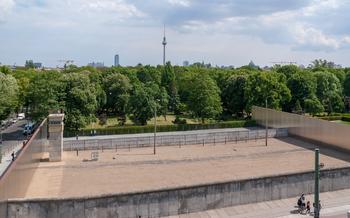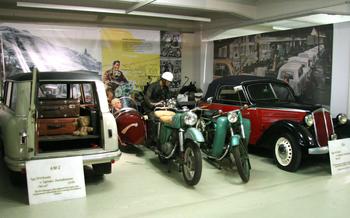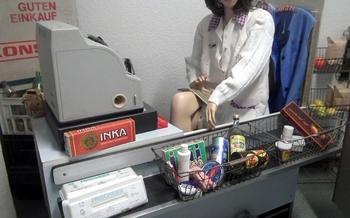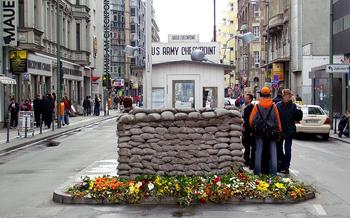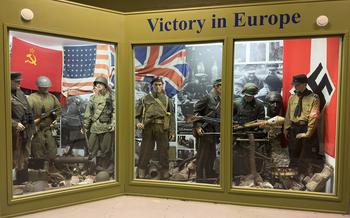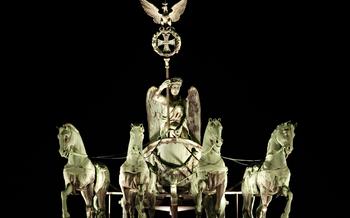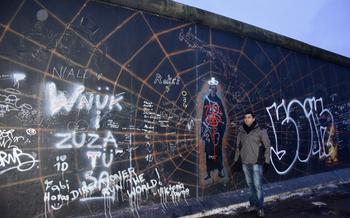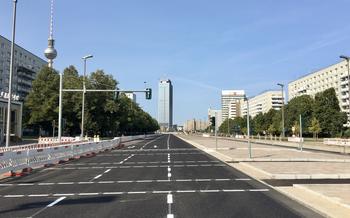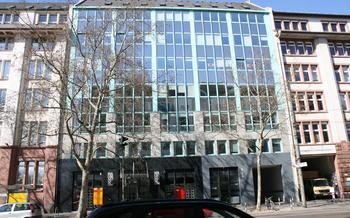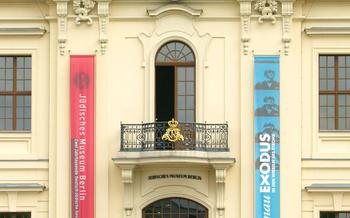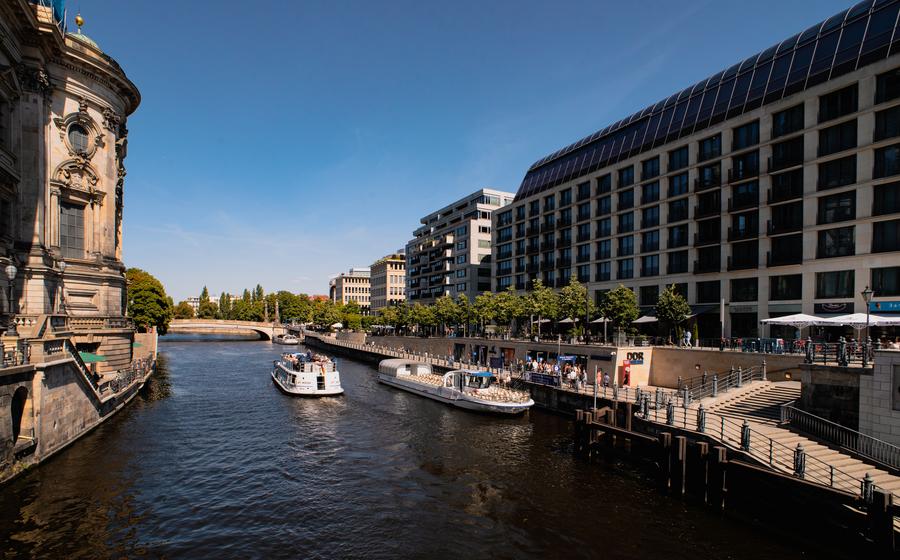
DDR Museum
- A Look into the Past: DDR Museum in Berlin
- Practical Information
- Authentic Artifacts and Personal Stories
- Trabant Cars and Wartburg Vehicles
- Stasi Surveillance and Secret Police
- Fall of the Berlin Wall and Peaceful Revolution
- Interactive Workshops and Educational Programs
- Temporary Exhibitions and Special Events
- Museum Shop and Café
- Educational Value and Historical Significance
- Accessibility and Visitor Information
- Personal Anecdote
- Location and Transportation
- Nearby Attractions and Points of Interest
- Online Resources and Virtual Tour
A Look into the Past: DDR Museum in Berlin
The DDR Museum in Berlin is a captivating journey through time, offering a profound insight into the history and culture of East Germany, also known as the German Democratic Republic (GDR). Established in 2006, the museum is housed in a former department store, providing a unique setting for exploring the complexities of life behind the Iron Curtain. Visitors embark on an immersive experience, engaging with interactive exhibits, multimedia presentations, and authentic artifacts that bring the GDR era to life. Whether you're a history buff, a curious traveler, or someone with a personal connection to East Germany, the DDR Museum offers a thought-provoking and poignant glimpse into a world that no longer exists.
Practical Information
- Location: Karl-Liebknecht-Str. 1, 10178 Berlin, Germany
- Opening Hours: Daily from 10 am to 8 pm
- Admission Fees: Regular admission: €00, Reduced admission: €00 (for students, seniors, and disabled visitors)
- Personal Anecdote: My first visit to the DDR Museum was a profoundly moving experience. As I stepped inside, I was immediately transported back in time, surrounded by objects and displays that evoked a sense of nostalgia and curiosity. The interactive exhibits allowed me to engage with the material in a hands-on way, immersing myself in the daily life and challenges faced by East Germans during that era.
Authentic Artifacts and Personal Stories
The DDR Museum brings the past to life through a remarkable collection of authentic artifacts and personal stories. Visitors can examine household items, clothing, and propaganda materials, gaining insights into the everyday lives of East Germans. Personal accounts from former East Germans offer a poignant glimpse into their experiences, struggles, and triumphs. Interactive stations invite visitors to share their own memories and experiences, creating a dialogue between the past and the present.
In one particularly moving exhibit, a former East German citizen shared her story of living under constant surveillance. She described how the Stasi monitored her phone calls, read her mail, and even searched her apartment. Her account highlighted the pervasive fear and paranoia that permeated East German society. As I listened to her story, I was struck by the courage and resilience of the East German people who lived under such oppressive conditions.
The museum also features a collection of iconic East German vehicles, including the Trabant and Wartburg. These cars were a symbol of both pride and frustration for East Germans. While they were often unreliable and difficult to maintain, they also represented a sense of independence and freedom. Visitors can learn about the history and cultural significance of these vehicles, and even experience driving or riding in them.
Trabant Cars and Wartburg Vehicles
Among the most iconic symbols of the GDR era are the Trabant and Wartburg vehicles, which hold a special place in the hearts of many East Germans. The DDR Museum showcases a collection of these classic cars, allowing visitors to step back in time and experience the automotive culture of East Germany.
Interactive exhibits provide visitors with the opportunity to virtually drive or ride in these vehicles, offering a unique and immersive experience. Visitors can learn about the history, production, and cultural significance of the Trabant and Wartburg, which were not only a means of transportation but also symbols of national pride and ingenuity.
Personal Anecdote:
During my visit to the DDR Museum, I had the chance to sit in a Trabant and experience its unique design firsthand. The car's simplicity and lack of modern amenities were striking, but I couldn't help but feel a sense of nostalgia and admiration for its enduring legacy. The Trabant, with its two-stroke engine and distinctive body shape, has become an iconic symbol of East Germany and a reminder of a bygone era.
Stasi Surveillance and Secret Police
The DDR Museum offers a chilling glimpse into the Stasi, the East German secret police, and their pervasive surveillance methods. Interactive exhibits showcase surveillance equipment and techniques, including hidden cameras, bugging devices, and secret listening posts. Visitors can learn about the Stasi's role in maintaining control and suppressing dissent, and the impact of their surveillance on the lives of ordinary citizens.
Personal Anecdote:
During my visit to the DDR Museum, I was particularly moved by an exhibit on the Stasi's use of informants. Former East Germans shared their personal stories of being recruited or coerced into spying on their friends, family, and neighbors. It was a sobering reminder of the extent to which the Stasi infiltrated every aspect of society, and the toll it took on individual lives.
Fall of the Berlin Wall and Peaceful Revolution
The DDR Museum vividly portrays the events leading to the fall of the Berlin Wall and the peaceful revolution that swept across East Germany in 198Through multimedia presentations and interactive displays, visitors gain insights into the circumstances that fueled the desire for change and the key moments that marked this transformative period.
Exhibits showcase the growing discontent among East Germans, the rise of protest movements, and the pivotal role played by ordinary citizens in demanding freedom and democracy. Visitors learn about the courageous individuals who dared to challenge the authoritarian regime, the mass demonstrations that took place, and the international solidarity that supported the East German people's struggle for self-determination.
A highlight of the museum's collection is the replica of the Berlin Wall, complete with watchtowers and barbed wire, serving as a poignant reminder of the oppressive division that existed during the Cold War era. Visitors can also witness the symbolic act of the wall being breached, a powerful representation of the triumph of freedom over oppression.
Through these immersive exhibits, the DDR Museum pays tribute to the bravery and resilience of the East German people, highlighting their unwavering determination to break free from the constraints of the communist regime and embrace a future of liberty and unity.
Interactive Workshops and Educational Programs
The DDR Museum offers a range of interactive workshops and educational programs for visitors of all ages. These programs provide an opportunity to engage with the museum's content in a deeper and more interactive way.
One popular workshop is the "Stasi Surveillance Simulation," where participants can experience firsthand the methods used by the East German secret police to spy on their citizens. Participants are given fake identities and must navigate a series of challenges, such as trying to avoid being followed or bugged.
Another popular program is the "Life in the GDR" workshop, where participants can learn about different aspects of everyday life in East Germany. They can try on traditional clothing, cook typical GDR dishes, and learn about the challenges and hardships faced by East Germans.
These workshops and educational programs are a great way to learn more about the history of East Germany and the GDR era in a fun and interactive way. They are suitable for visitors of all ages and backgrounds, and they can be booked in advance or on the day of your visit.
Personal Anecdote:
I had the opportunity to participate in the "Stasi Surveillance Simulation" workshop during my visit to the DDR Museum. It was a fascinating and eye-opening experience to learn about the methods used by the Stasi to spy on their citizens. I was particularly struck by the fact that the Stasi often used ordinary people as informants, and that even the most mundane details of people's lives could be used against them.
The workshop was also a lot of fun, and it was interesting to try to avoid being followed or bugged. I would highly recommend this workshop to anyone who is interested in learning more about the Stasi and the GDR era.
Temporary Exhibitions and Special Events
The DDR Museum regularly hosts temporary exhibitions that delve deeper into specific topics related to East Germany and the GDR era. These exhibitions often showcase unique artifacts, documents, and personal stories that provide visitors with a more nuanced understanding of this complex period in history. The museum also organizes special events, such as lectures, workshops, and film screenings, which offer visitors the opportunity to engage with experts, researchers, and former East Germans who lived through these times. These events provide a platform for discussions, debates, and the sharing of personal experiences, enriching the museum's educational mission and fostering a deeper understanding of the GDR era.
Personal Anecdote:
During my visit to the DDR Museum, I had the opportunity to attend a special event focused on the role of women in East German society. The event featured a panel discussion with former East German women who shared their personal experiences and perspectives on topics such as education, employment, and family life. It was incredibly moving to hear their stories firsthand and to gain insights into the challenges and triumphs they faced as women living in a socialist society. The event provided a valuable complement to the museum's permanent exhibits, offering a more personal and nuanced understanding of the GDR era.
Museum Shop and Café
The DDR Museum also features a well-stocked museum shop where visitors can purchase a variety of souvenirs and memorabilia related to the GDR era. From books and DVDs to clothing and accessories, there's something for everyone interested in taking home a piece of history.
The museum café, located on the ground floor, offers a delightful menu of refreshments and snacks, including East German specialties such as Soljanka soup and Buletten meatballs. Visitors can relax and refuel after their museum visit while enjoying the unique atmosphere of the café, which is decorated with authentic GDR-era artifacts.
In a personal anecdote, I recall browsing the museum shop and being fascinated by the variety of items on display. I purchased a replica of a Stasi surveillance camera as a souvenir, as well as a book about the history of the GDR.
I also enjoyed a delicious lunch at the museum café, where I tried the Soljanka soup and found it to be hearty and flavorful. The café's atmosphere was relaxed and inviting, and it was a great place to reflect on the museum's exhibits while enjoying a tasty meal.
Educational Value and Historical Significance
The DDR Museum serves as a vital repository of knowledge and understanding of East Germany's history and the GDR era. It plays a crucial role in preserving and presenting this unique chapter of history to visitors from all over the world. Through its immersive exhibits, interactive displays, and personal stories, the museum offers an in-depth exploration of the political, cultural, and social aspects of life in East Germany.
The museum's educational value extends to visitors of all ages and backgrounds. It provides a unique opportunity for younger generations to learn about a period that may be unfamiliar to them, fostering a deeper appreciation for history. For those who lived through the GDR era, the museum offers a chance to revisit their past, share their experiences, and contribute to a collective understanding of this complex time.
Beyond its educational value, the DDR Museum also holds significant historical significance. It stands as a testament to the resilience and determination of the East German people, who peacefully brought about the fall of the Berlin Wall and the end of the communist regime. The museum serves as a reminder of the importance of freedom, democracy, and human rights, and it inspires visitors to reflect on the lessons of history and the pursuit of a more just and equitable society.
Personal Anecdote
During my visit to the DDR Museum, I was struck by the power of the personal stories shared by former East Germans. One particular story that resonated with me was that of a woman who had been imprisoned by the Stasi for her involvement in the peaceful revolution. She spoke of the hardships she endured and the courage she found within herself to stand up for her beliefs. Her story was a powerful reminder of the human cost of oppression and the importance of fighting for freedom.
Accessibility and Visitor Information
The DDR Museum is committed to providing an accessible and inclusive experience for all visitors. The museum offers a range of accessibility features, including wheelchair ramps, elevators, and accessible restrooms. Multilingual audio guides and informational materials are available in English, German, French, Spanish, and Russian, ensuring that visitors from all over the world can fully engage with the museum's exhibits. Guided tours are also available in different languages, providing visitors with a deeper understanding of the museum's content and historical context.
To ensure a smooth and enjoyable visit, it is recommended that visitors plan their trip in advance. The museum's website provides detailed information on accessibility features, guided tours, and visitor services. Visitors can also contact the museum directly for assistance or to inquire about specific needs.
Personal Anecdote
During my recent visit to the DDR Museum, I was impressed by the museum's commitment to accessibility. As a wheelchair user, I found the museum to be well-equipped and easy to navigate. The staff were friendly and helpful, and they went out of their way to ensure that I had a positive experience. I was particularly grateful for the availability of multilingual audio guides, which allowed me to fully understand the exhibits and learn more about the history of East Germany.
Location and Transportation
The DDR Museum is strategically situated in the heart of Berlin, at Karl-Liebknecht-Straße 1, 10178 Berlin, Germany. Its prime location places it within easy reach of other prominent historical sites and attractions that narrate the city's rich tapestry of history. The Brandenburg Gate, the Reichstag Building, and the Berlin Wall Memorial are just a stone's throw away, inviting visitors to embark on a journey through time, exploring the different chapters that have shaped Berlin's identity.
Reaching the DDR Museum is a breeze, thanks to Berlin's efficient public transportation system. The U-Bahn (underground train) and S-Bahn (city train) lines offer convenient connections to the museum. The nearest U-Bahn station is Spittelmarkt, while the closest S-Bahn station is Friedrichstraße. From either station, it's just a short walk to the museum's doorstep.
For those who prefer to travel by car, the DDR Museum provides ample parking facilities. The APCOA parking garage on Leipziger Straße 126 offers secure and convenient parking options, ensuring a hassle-free visit.
Whether you choose to navigate Berlin's public transportation network or arrive by car, the DDR Museum is easily accessible, inviting you to delve into the captivating history of East Germany and the GDR era.
Nearby Attractions and Points of Interest
The DDR Museum is strategically located in the heart of Berlin, surrounded by a treasure trove of historical sites and cultural attractions. A short walk from the museum, visitors can explore the iconic Brandenburg Gate, a symbol of German reunification, and the Reichstag Building, the seat of the German parliament. For those interested in delving deeper into Berlin's tumultuous past, the Topography of Terror, a museum dedicated to the history of the Nazi SS and Gestapo, is a must-visit.
Art enthusiasts will delight in the nearby Pergamon Museum, home to world-renowned collections of ancient Near Eastern and Islamic art, including the awe-inspiring Ishtar Gate of Babylon. The Jewish Museum Berlin, with its poignant exhibitions on Jewish history and culture, is another significant landmark in the area. To experience the vibrant atmosphere of Berlin's contemporary art scene, visitors can head to the nearby KW Institute for Contemporary Art or the Hamburger Bahnhof, a museum dedicated to modern and contemporary art.
For those seeking a break from history and culture, the Tiergarten Park, one of Berlin's largest and most beautiful green spaces, offers a tranquil escape just steps away from the DDR Museum. With its lush gardens, serene lakes, and abundant wildlife, the park is a perfect place to relax and recharge.
By combining a visit to the DDR Museum with other nearby attractions, visitors can create a comprehensive itinerary that provides a multifaceted perspective on Berlin's rich history and vibrant culture. Whether you're interested in art, history, or simply soaking up the atmosphere of this dynamic city, there's something for everyone in the vicinity of the DDR Museum.
Online Resources and Virtual Tour
The DDR Museum's website serves as a comprehensive online resource for those interested in exploring the history and culture of East Germany. The virtual tour offers a unique opportunity to experience the museum's exhibitions from the comfort of one's own home. Through interactive presentations and multimedia content, visitors can delve into the different aspects of life in the GDR, from politics and culture to everyday life.
The museum's social media channels provide a platform for engagement and interaction with visitors. Regular updates, behind-the-scenes glimpses, and educational content keep followers connected to the museum's activities and exhibitions. Visitors can also share their own memories and experiences related to the GDR era, fostering a sense of community and collective remembrance.
Through its online presence, the DDR Museum extends its reach beyond its physical walls, allowing individuals worldwide to learn about and engage with East Germany's history. The virtual tour and interactive content make the museum accessible to a broader audience, promoting understanding and preserving the memory of this significant period in German history.
